Elderly Residents’ Uses of and Preferences for Community Outdoor Spaces during Heat Periods
Abstract
1. Introduction
1.1. Aging-Friendly Community Outdoor Environment
1.2. The Planning and Design of Community Outdoor Space
2. Theoretical Frameworks
2.1. Environmental Factors Influencing Behavioral Preferences
2.2. Elderly Residents’s Subjective Preferences for Outdoor Environments
2.3. Association between Behavioral Preferences and the Environment
2.4. Aim of This Study
3. Methodology
3.1. Methodology Overview
3.2. Study Area
3.3. Data Collection
3.4. Data Analysis
3.4.1. Image Recognition Technology
3.4.2. Correlation Analysis
3.4.3. Model Building
3.4.4. Evaluation Indicators and Datasets
4. Results
4.1. Measurement Results
4.2. Correlation Analysis Results
4.3. Model Building
5. Discussion
5.1. Age-Friendly Renovation in Community Outdoor Spaces
5.2. Strategies for Updating Community Outdoor Spaces
6. Conclusions
- (1)
- This study clearly reveals the relationship between thermal environment, noise, pedestrian traffic, and the number of residents staying in outdoor spaces. The environmental elements affecting the usage of outdoor spaces by community residents, especially the elderly, are temperature, relative humidity, pedestrian traffic, and noise, in that order.
- (2)
- The temperature is negatively correlated with the elderly’s spontaneous usage of outdoor spaces. Although the elderly’s ability to perceive heat is weakened, they prefer to choose shaded spaces for leisure and communication in summer.
- (3)
- The pedestrian traffic of the road is positively correlated with the number of residents staying in nearby outdoor spaces, indicating that the elderly prefer to use outdoor spaces in locations such as traffic intersections and roadsides with large pedestrian traffic.
- (4)
- Noise is positively correlated with the elderly’s usage of outdoor spaces. Elderly residents are not highly sensitive to noise but rather like lively outdoor environments, which may have potential association with their psychological state of loneliness.
- (5)
- The random forest regression model predicts the number of residents staying in community outdoor spaces with the best effect (R2 = 0.7958), with independent variables being temperature, relative humidity, pedestrian traffic, and noise, in that order.
Author Contributions
Funding
Institutional Review Board Statement
Informed Consent Statement
Data Availability Statement
Conflicts of Interest
References
- Li, J.M.; Han, X.L.; Zhang, X.X.; Wang, S.X. Spatiotemporal evolution of global population ageing from 1960 to 2017. BMC Public Health 2019, 19, 127. [Google Scholar] [CrossRef] [PubMed]
- Bulletin of the 7th National Census of Yuexiu District, Guangzhou, China. Available online: http://www.yuexiu.gov.cn/zwgk/sjfb/tjgb/content/post_7326279.html (accessed on 25 June 2023).
- Lak, A.; Aghamolaei, R.; Baradaran, H.R.; Myint, P.K. A Framework for Elder-Friendly Public Open Spaces from the Iranian Older Adults’ perspectives: A Mixed-Method Study. Urban For. Urban Green. 2020, 56, 126857. [Google Scholar] [CrossRef]
- Chang, P.-J.; Wray, L.; Lin, Y. Social relationships, leisure activity, and health in older adults. Health Psychol. 2014, 33, 516. [Google Scholar] [CrossRef] [PubMed]
- Koohsari, M.J.; Mavoa, S.; Villanueva, K.; Sugiyama, T.; Badland, H.; Kaczynski, A.T.; Owen, N.; Giles-Corti, B.J.H. Public open space, physical activity, urban design and public health: Concepts, methods and research agenda. Health Place 2015, 33, 75–82. [Google Scholar] [CrossRef]
- Mohammad-Moradi, A.; Yazdanfar, S.-A.; Norouzian-Maleki, S. Technology. Exploring the Sense of Place Components in Historic Districts: A Strategy for Urban Designers and Architects. Iran Univ. Sci. Technol. 2020, 30, 30–43. [Google Scholar]
- Motomura, M.; Koohsari, M.J.; Lin, C.-Y.; Ishii, K.; Shibata, A.; Nakaya, T.; Kaczynski, A.T.; Veitch, J.; Oka, K. Associations of public open space attributes with active and sedentary behaviors in dense urban areas: A systematic review of observational studies. Health Place 2022, 75, 102816. [Google Scholar] [CrossRef]
- Wei, Z.; Jiejing, W.; Bo, Q.J.L. Quantity or quality? Exploring the association between public open space and mental health in urban China. Landsc. Urban Plan. 2021, 213, 104128. [Google Scholar]
- Jian, I.Y.; Chan, E.H.; Xu, Y.; Owusu, E.K. Inclusive public open space for all: Spatial justice with health considerations. Habitat Int. 2021, 118, 102457. [Google Scholar] [CrossRef]
- Kemperman, A.; Timmermans, H. Green spaces in the direct living environment and social contacts of the aging population. Landsc. Urban Plan. 2014, 129, 44–54. [Google Scholar] [CrossRef]
- Van Melik, R.; Pijpers, R. Older people’s self–selected spaces of encounter in urban aging environments in the Netherlands. City Community 2017, 16, 284–303. [Google Scholar] [CrossRef]
- Pijpers, R.; van Melik, R.J.H.D.; Ly Serena, K. Looking, observing, watching: Meaningful contact at a distance. In Age-Inclusive Public Space; Hatje Cantz Verlag: Berlin, Germany, 2020; pp. 81–83. [Google Scholar]
- World Health Organization. Global Age-Friendly Cities: A Guide; World Health Organization: Geneva, Switzerland, 2007. [Google Scholar]
- Jia, S.; Wang, Y.; Wong, N.H.; Chen, W.; Ding, X. Environment. Influences of the thermal environment on pedestrians’ thermal perception and travel behavior in hot weather. Build. Environ. 2022, 226, 109687. [Google Scholar] [CrossRef]
- Liu, J.; Wei, Y.; Lu, S.; Wang, R.; Chen, L.; Xu, F. The elderly’s preference for the outdoor environment in Fragrant Hills Nursing Home, Beijing: Interpreting the visual-behavioural relationship. Urban For. Urban Green. 2021, 64, 127242. [Google Scholar] [CrossRef]
- Yung, E.H.K.; Ho, W.K.O.; Chan, E.H.W. Elderly satisfaction with planning and design of public parks in high density old districts: An ordered logit model. Landsc. Urban Plan. 2017, 165, 39–53. [Google Scholar]
- Yu, S.; Guo, N.; Zheng, C.; Song, Y.; Hao, J. Investigating the association between outdoor environment and outdoor activities for seniors living in old residential communities. J. Environ. Res. Public Health 2021, 18, 7500. [Google Scholar] [CrossRef] [PubMed]
- Böcker, L.; Uteng, T.P.; Liu, C.; Dijst, M. Weather and daily mobility in international perspective: A cross-comparison of Dutch, Norwegian and Swedish city regions. Transp. Res. Part D Transp. Environ. 2019, 77, 491–505. [Google Scholar] [CrossRef]
- Labdaoui, K.; Mazouz, S.; Acidi, A.; Cools, M.; Moeinaddini, M.; Teller, J. Utilizing thermal comfort and walking facilities to propose a comfort walkability index (CWI) at the neighbourhood level. Build. Environ. 2021, 193, 107627. [Google Scholar] [CrossRef]
- Sugiyama, T.; Gunn, L.D.; Christian, H.; Francis, J.; Foster, S.; Hooper, P.; Owen, N.; Giles-Corti, B. Quality of public open spaces and recreational walking. Am. J. Public Health 2015, 105, 2490–2495. [Google Scholar] [CrossRef] [PubMed]
- Močnik, Š.; Moogoor, A.; Yuen, B. Exploring facilitators and barriers of older adults’ outdoor mobility: A walk-along study in Singapore. J. Transp. Health 2022, 26, 101386. [Google Scholar] [CrossRef]
- Huang, T.; Li, J.; Xie, Y.; Niu, J.; Mak, C.M. Simultaneous environmental parameter monitoring and human subject survey regarding outdoor thermal comfort and its modelling. Build. Environ. 2017, 125, 502–514. [Google Scholar] [CrossRef]
- Nikolopoulou, M.; Steemers, K. Thermal comfort and psychological adaptation as a guide for designing urban spaces. Energy Build. 2003, 35, 95–101. [Google Scholar] [CrossRef]
- Nikolopoulou, M.; Lykoudis, S. Use of outdoor spaces and microclimate in a Mediterranean urban area. Build. Environ. 2007, 42, 3691–3707. [Google Scholar] [CrossRef]
- Huang, J.; Zhou, C.; Zhuo, Y.; Xu, L.; Jiang, Y. Outdoor thermal environments and activities in open space: An experiment study in humid subtropical climates. Build. Environ. 2016, 103, 238–249. [Google Scholar] [CrossRef]
- Lee, L.S.; Cheung, P.K.; Fung, C.K.; Jim, C.Y. Improving street walkability: Biometeorological assessment of artificial-partial shade structures in summer sunny conditions. Int. J. Biometeorol. 2020, 64, 547–560. [Google Scholar] [CrossRef] [PubMed]
- Peng, S.; Maing, M. Influential factors of age-friendly neighborhood open space under high-density high-rise housing context in hot weather: A case study of public housing in Hong Kong. Cities 2021, 115, 103231. [Google Scholar] [CrossRef]
- Lottrup, L.; Stigsdotter, U.K.; Meilby, H.; Corazon, S.S. Associations between use, activities and characteristics of the outdoor environment at workplaces. Urban For. Urban Green. 2012, 11, 159–168. [Google Scholar] [CrossRef]
- Li, K.; Zhang, Y.; Zhao, L. Outdoor thermal comfort and activities in the urban residential community in a humid subtropical area of China. Energy Build. 2016, 133, 498–511. [Google Scholar] [CrossRef]
- Lamour, Q.; Morelli, A.M.; Marins, K.R.D.C. Improving walkability in a TOD context: Spatial strategies that enhance walking in the Belém neighbourhood, in São Paulo, Brazil. Case Stud. Transp. Policy 2019, 7, 280–292. [Google Scholar] [CrossRef]
- Larriva, M.T.B.; Higueras, E. Health risk for older adults in Madrid, by outdoor thermal and acoustic comfort. Urban Clim. 2020, 34, 100724. [Google Scholar] [CrossRef]
- Herranz-Pascual, K.; Iraurgi, I.; Aspuru, I.; Garcia-Pérez, I.; Santander, A.; Eguiguren, J.L. Integrating soundscape criteria in urban sustainable regeneration processes: An example of comfort and health improvement. Sustainability 2022, 14, 3143. [Google Scholar] [CrossRef]
- Gamero-Salinas, J.; Kishnani, N.; Monge-Barrio, A.; López-Fidalgo, J.; Sánchez-Ostiz, A. Evaluation of thermal comfort and building form attributes in different semi-outdoor environments in a high-density tropical setting. Build. Environ. 2021, 205, 108255. [Google Scholar] [CrossRef]
- Atuoye, K.N.; Luginaah, I.; Hambati, H.; Campbell, G. Politics, economics, how about our health? Impacts of large-scale land acquisitions on therapeutic spaces and wellbeing in coastal Tanzania. Soc. Sci. Med. 2019, 220, 283–291. [Google Scholar] [CrossRef] [PubMed]
- Finlay, J.M. ‘Walk like a penguin’: Older Minnesotans’ experiences of (non) therapeutic white space. Soc. Sci. Med. 2018, 198, 77–84. [Google Scholar] [CrossRef] [PubMed]
- Triguero-Mas, M.; Anguelovski, I.; García-Lamarca, M.; Argüelles, L.; Perez-del-Pulgar, C.; Shokry, G.; Connolly, J.J.; Cole, H.V. Natural outdoor environments’ health effects in gentrifying neighborhoods: Disruptive green landscapes for underprivileged neighborhood residents. Soc. Sci. Med. 2021, 279, 113964. [Google Scholar] [CrossRef]
- Middleton, J. The socialities of everyday urban walking and the ‘right to the city’. Urban Stud. 2018, 55, 296–315. [Google Scholar] [CrossRef]
- Cambra, P.; Moura, F. How does walkability change relate to walking behavior change? Effects of a street improvement in pedestrian volumes and walking experience. J. Transp. Health 2020, 16, 100797. [Google Scholar] [CrossRef]
- Lee, S.; Talen, E. Measuring walkability: A note on auditing methods. J. Urban Des. 2014, 19, 368–388. [Google Scholar] [CrossRef]
- Chen, L.; Lu, Y.; Sheng, Q.; Ye, Y.; Wang, R.; Liu, Y. Estimating pedestrian volume using Street View images: A large-scale validation test. Comput. Environ. Urban Syst. 2020, 81, 101481. [Google Scholar] [CrossRef]
- Yıldız, M.; Varol, E.; Elkoca, A.; Yildirim, M.S.; Sarpdağı, Y. Determining the correlation between old age adaptation, aging in place and depression in older adults: A descriptive correlational study. Arch. Psychiatr. Nurs. 2023, 43, 153–161. [Google Scholar] [CrossRef]
- Bottini, L. The effects of built environment on community participation in urban neighbourhoods: An empirical exploration. Cities 2018, 81, 108–114. [Google Scholar] [CrossRef]
- Zhang, Z.; Feng, L.; Hu, L.; Cao, Y. Older residents’ sense of home and homemaking in rural-urban resettlement: A case study of “moving-merging” community in Shanghai. Habitat Int. 2022, 126, 102616. [Google Scholar] [CrossRef]
- Gaikwad, A.; Shinde, K. Use of parks by older persons and perceived health benefits: A developing country context. Cities 2019, 84, 134–142. [Google Scholar] [CrossRef]
- Sun, X.; Wang, L.; Wang, F.; Soltani, S. Behaviors of seniors and impact of spatial form in small-scale public spaces in Chinese old city zones. Cities 2020, 107, 102894. [Google Scholar] [CrossRef]
- Paukaeva, A.A.; Setoguchi, T.; Luchkova, V.I.; Watanabe, N.; Sato, H. Impacts of the temporary urban design on the people’s behavior-The case study on the winter city Khabarovsk, Russia. Cities 2021, 117, 103303. [Google Scholar] [CrossRef]
- Lin, T.-P.; Tsai, K.-T.; Hwang, R.-L.; Matzarakis, A. Quantification of the effect of thermal indices and sky view factor on park attendance. Landsc. Urban Plan. 2012, 107, 137–146. [Google Scholar] [CrossRef]
- Mao, Y.; Qi, J.; He, B.-J. Impact of the heritage building façade in small-scale public spaces on human activity: Based on spatial analysis. Environ. Impact Assess. Rev. 2020, 85, 106457. [Google Scholar] [CrossRef]
- Blatteis, C.M. Age-dependent changes in temperature regulation–A mini review. Gerontology 2012, 58, 289–295. [Google Scholar] [CrossRef] [PubMed]
- Ewing, R.; Clemente, O.; Neckerman, K.M.; Purciel-Hill, M.; Quinn, J.W.; Rundle, A. Measuring Urban Design: Metrics for Livable Places; Springer: Berlin/Heidelberg, Germany, 2013; Volume 200. [Google Scholar]
- Kim, S.W.; Brown, R.D. Pedestrians’ behavior based on outdoor thermal comfort and micro-scale thermal environments, Austin, TX. Sci. Total Environ. 2022, 808, 152143. [Google Scholar] [CrossRef]
- Rotton, J.; Shats, M.; Standers, R. Temperature and pedestrian tempo: Walking without awareness. Environ. Behav. 1990, 22, 650–674. [Google Scholar] [CrossRef]
- Saneinejad, S.; Roorda, M.J.; Kennedy, C. Modelling the impact of weather conditions on active transportation travel behaviour. Transp. Res. Part D Transp. Environ. 2012, 17, 129–137. [Google Scholar] [CrossRef]
- Moon, J.W. Performance of ANN-based predictive and adaptive thermal-control methods for disturbances in and around residential buildings. Build. Environ. 2012, 48, 15–26. [Google Scholar] [CrossRef]
- Chan, S.Y.; Chau, C.K. Development of artificial neural network models for predicting thermal comfort evaluation in urban parks in summer and winter. Build. Environ. 2019, 164, 106364. [Google Scholar] [CrossRef]
- Asur, F.; Deniz, S.S.; Yazici, K. Visual Preferences Assessment of Landscape Character Types Using Data Mining Methods (Apriori Algorithm): The Case of Altinsac and Inkoy (Van/Turkey). J. Agric. Sci. Technol. 2020, 22, 247–260. [Google Scholar]
- Bureau of Forestry and Landscaping of Guangzhou Municipality. Available online: http://lyylj.gz.gov.cn/zwgk/sjfb/content/post_8555619.html (accessed on 25 June 2023).
- People’s Government of Yuexiu District, Guangzhou. Available online: http://www.yuexiu.gov.cn/zzfw/zfwj/content/post_8768606.html (accessed on 25 June 2023).
- Cover, T.; Hart, P. Nearest neighbor pattern classification. IEEE Trans. Inf. Theory 1967, 13, 21–27. [Google Scholar] [CrossRef]
- Smola, A.J.; Schölkopf, B. A tutorial on support vector regression. Stat. Comput. 2004, 14, 199–222. [Google Scholar] [CrossRef]
- Mason, R.; Brown, W.G. Multicollinearity problems and ridge regression in sociological models. Soc. Sci. Res. 1975, 4, 135–149. [Google Scholar] [CrossRef]
- Loh, W.Y. Fifty years of classification and regression trees. Int. Stat. Rev. 2014, 82, 329–348. [Google Scholar] [CrossRef]
- Chaudhury, H.; Mahmood, A.; Michael, Y.L.; Campo, M.; Hay, K. The influence of neighborhood residential density, physical and social environments on older adults’ physical activity: An exploratory study in two metropolitan areas. J. Aging Stud. 2012, 26, 35–43. [Google Scholar] [CrossRef]
- Scheidt, R.J.; Humpherys, D.R.; Yorgason, J.B. Successful aging: What’s not to like? J. Appl. Gerontol. 1999, 18, 277–282. [Google Scholar] [CrossRef]
- Meggiolaro, S.; Ongaro, F. Life satisfaction among older people in Italy in a gender approach–Corrigendum. Ageing Soc. 2015, 35, 1564. [Google Scholar] [CrossRef]
- Yung, E.H.; Conejos, S.; Chan, E.H. Social needs of the elderly and active aging in public open spaces in urban renewal. Cities 2016, 52, 114–122. [Google Scholar] [CrossRef]
- Kelley, J.; Dannefer, D.; Masarweh, L.; Buffel, T.; Handler, S.; Phillipson, C. Age-Friendly Cities and Communities: A Global Perspective; Bristol University Press: Bristol, UK, 2018. [Google Scholar]
- Plouffe, L.; Kalache, A. Towards global age-friendly cities: Determining urban features that promote active aging. J. Urban Health 2010, 87, 733–739. [Google Scholar] [CrossRef] [PubMed]
- Aşur, F.; Akpınar Külekçi, E. The Relationship Between the Adorability of Urban Landscapes and Their Users Demographic Variables: The Case of Edremit, Van/Turkey. J. Int. Environ. Appl. Sci. 2020, 15, 19–25. [Google Scholar]
- Zhao, M.; Chen, S. A Survey on Senior/Elderly Participation in Leisure Activity in Hong Kong. Asian J. Exerc. Sport. Sci. 2013, 10, 92–101. [Google Scholar]
- Yung, E.H.K.; Wang, S.; Chau, C.-K. Thermal perceptions of the elderly, use patterns and satisfaction with open space. Landsc. Urban Plan. 2019, 185, 44–60. [Google Scholar] [CrossRef]
- Bhuyan, M.R.; Lane, A.P.; Moogoor, A.; Močnik, Š.; Yuen, B. Meaning of age-friendly neighbourhood: An exploratory study with older adults and key informants in Singapore. Cities 2020, 107, 102940. [Google Scholar] [CrossRef]
- Yen, H.-Y.; Lin, L.-J. Quality of life in older adults: Benefits from the productive engagement in physical activity. J. Exerc. Sci. Fit. 2018, 16, 49–54. [Google Scholar] [CrossRef] [PubMed]
- Liddle, J.; Ireland, D.; McBride, S.J.; Brauer, S.G.; Hall, L.M.; Ding, H.; Karunanithi, M.; Hodges, P.W.; Theodoros, D.; Silburn, P.A.; et al. Measuring the lifespace of people with Parkinson’s disease using smartphones: Proof of principle. JMIR mHealth uHealth 2014, 2, e2799. [Google Scholar] [CrossRef] [PubMed]
- Douma, L.; Steverink, N.; Meijering, L. Geographical life-space and subjective wellbeing in later life. Health Place 2021, 70, 102608. [Google Scholar] [CrossRef]

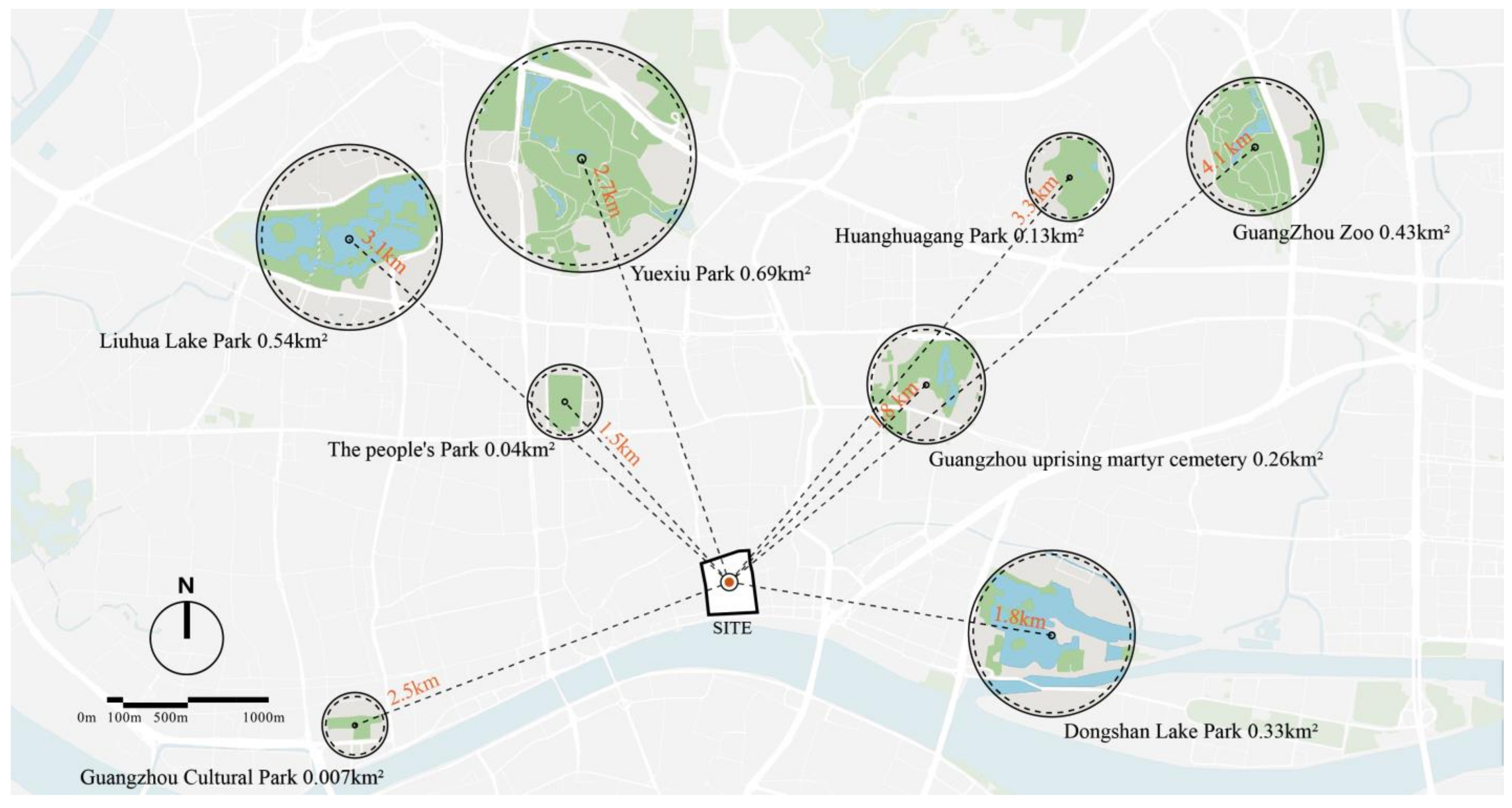
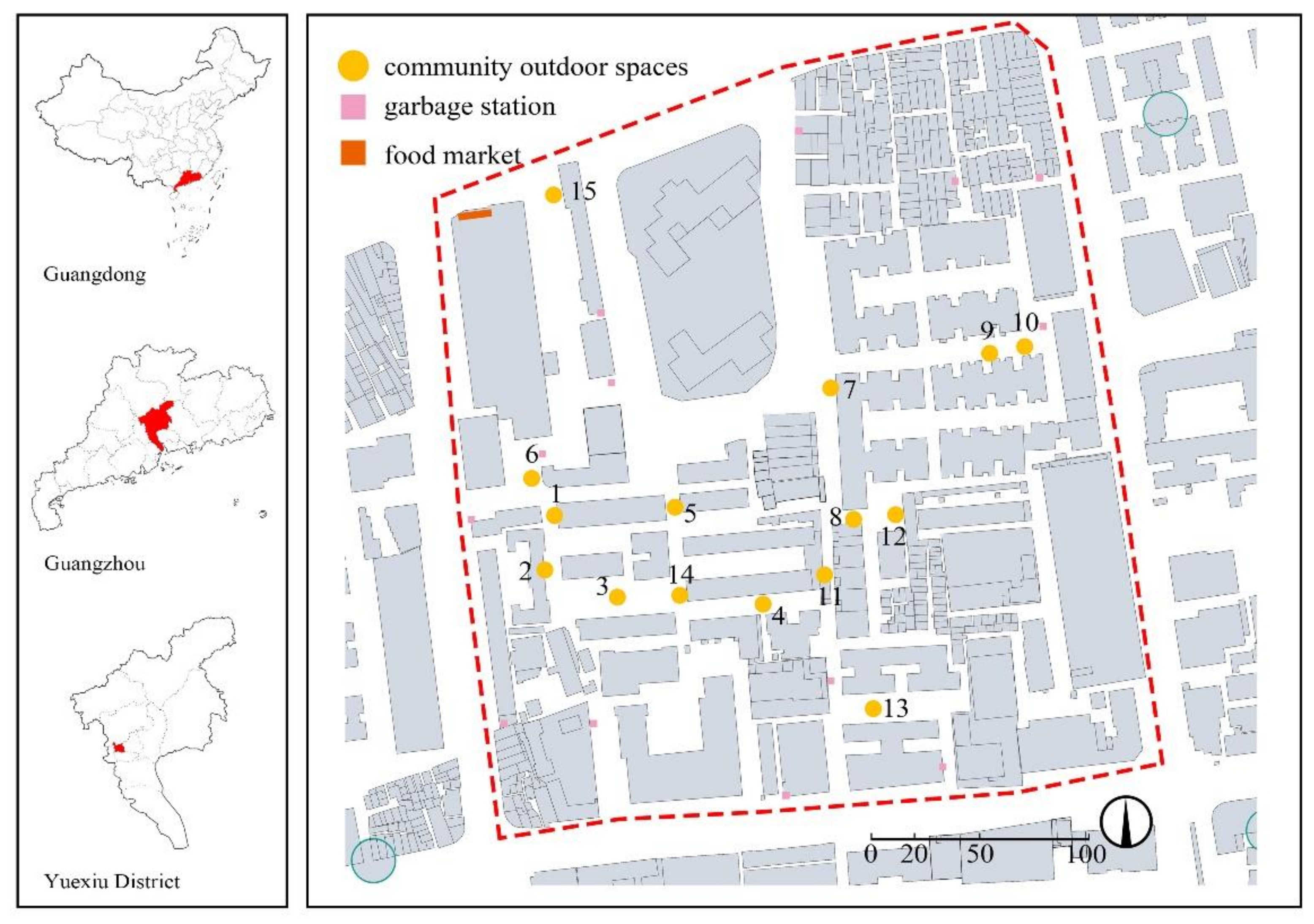

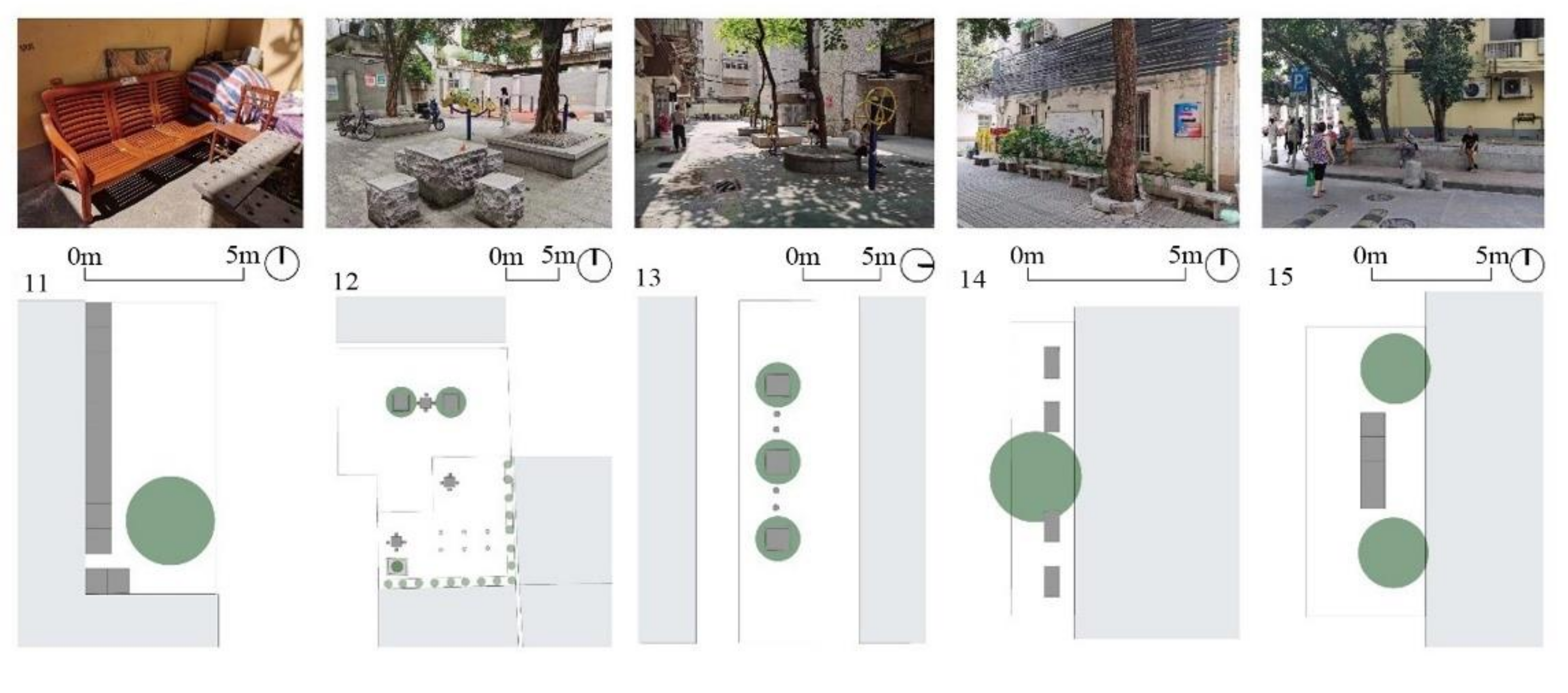


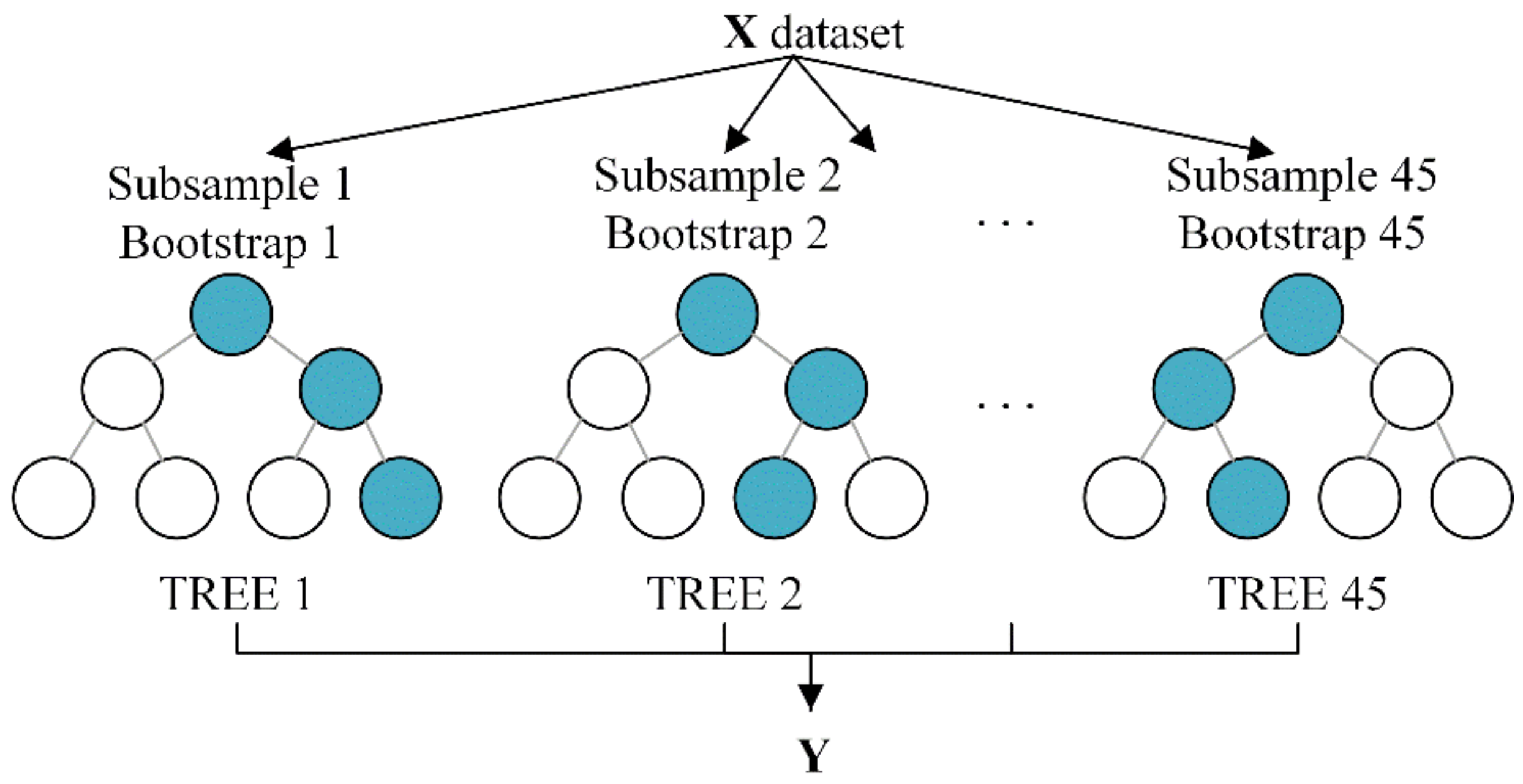
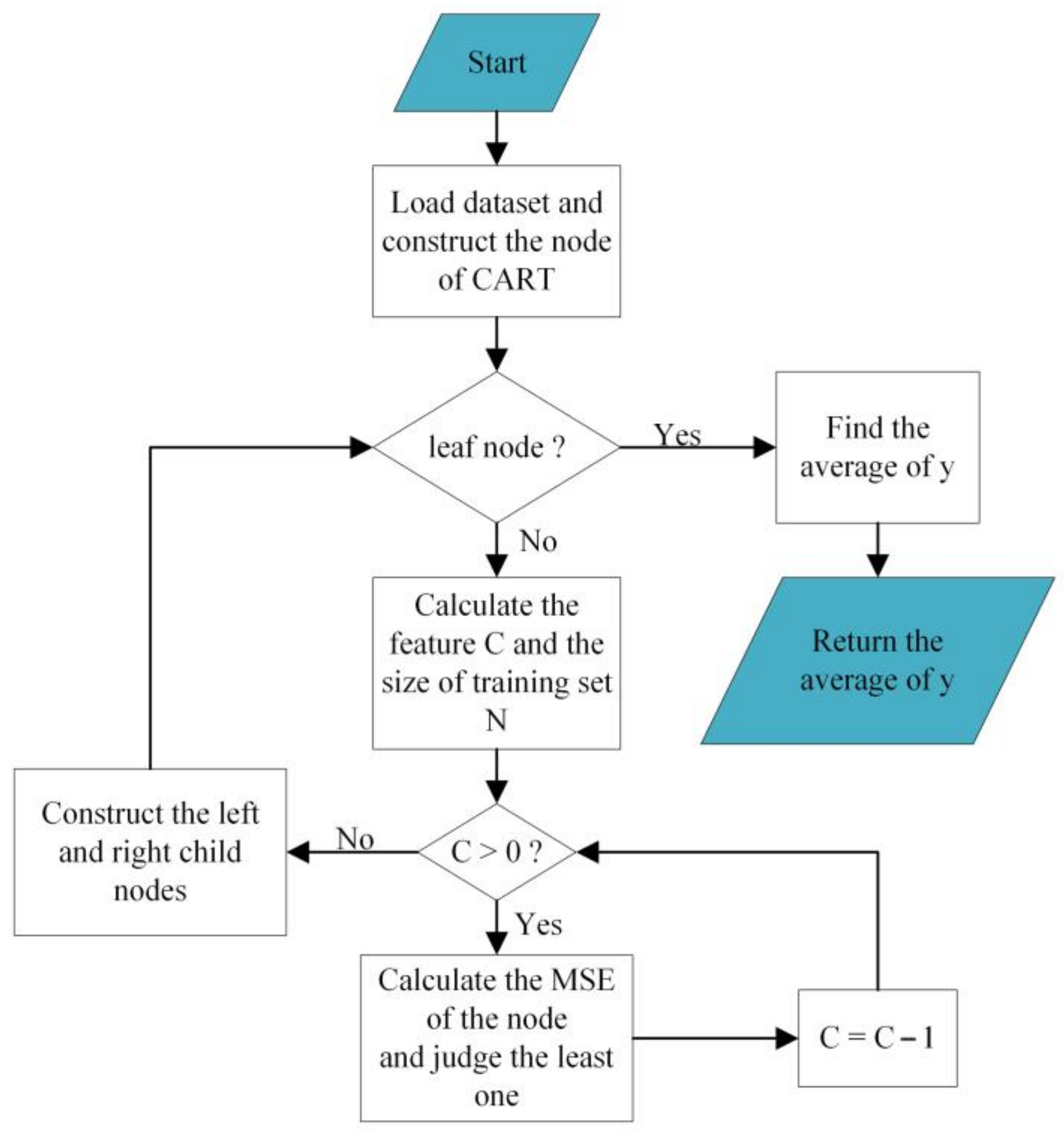

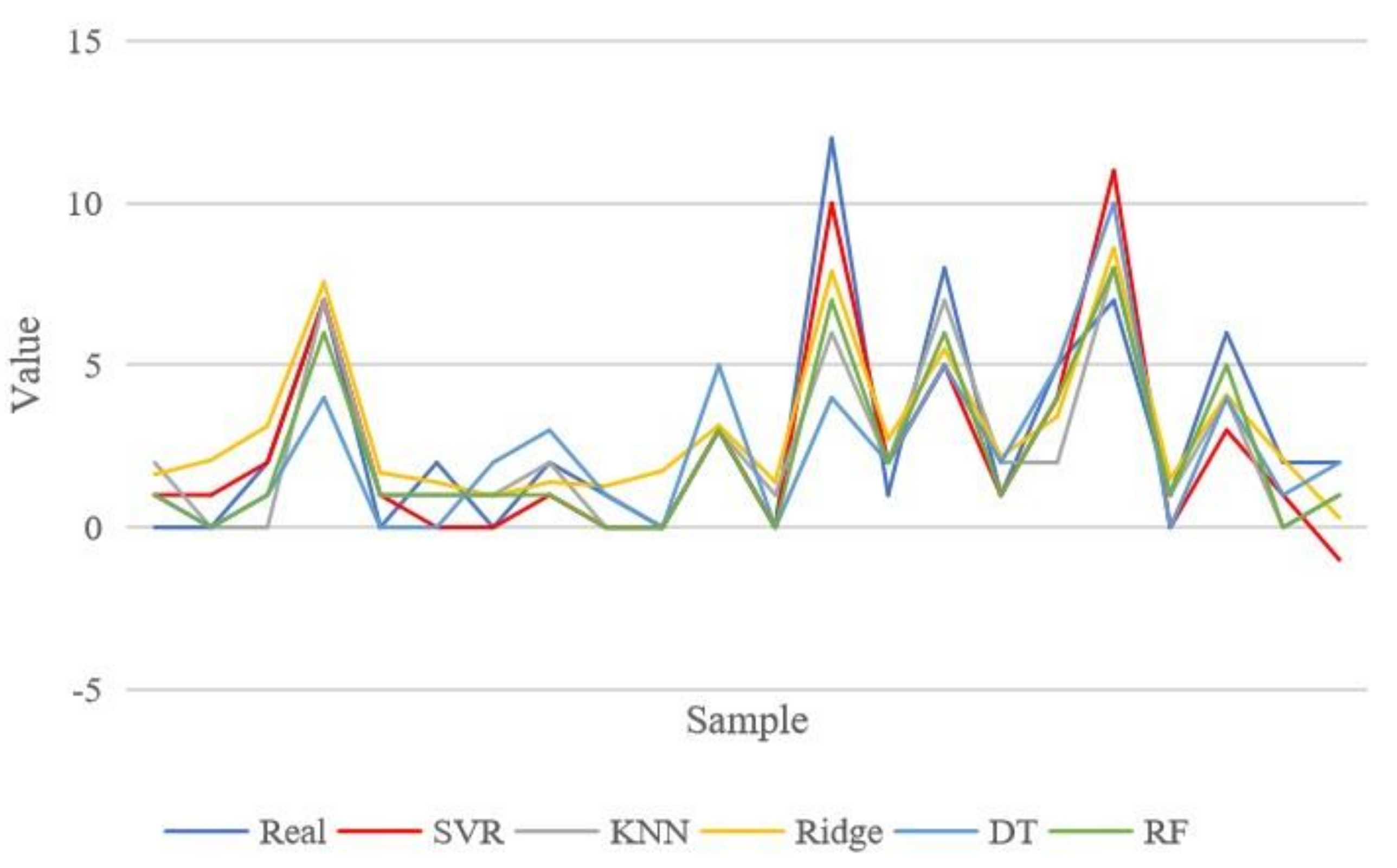
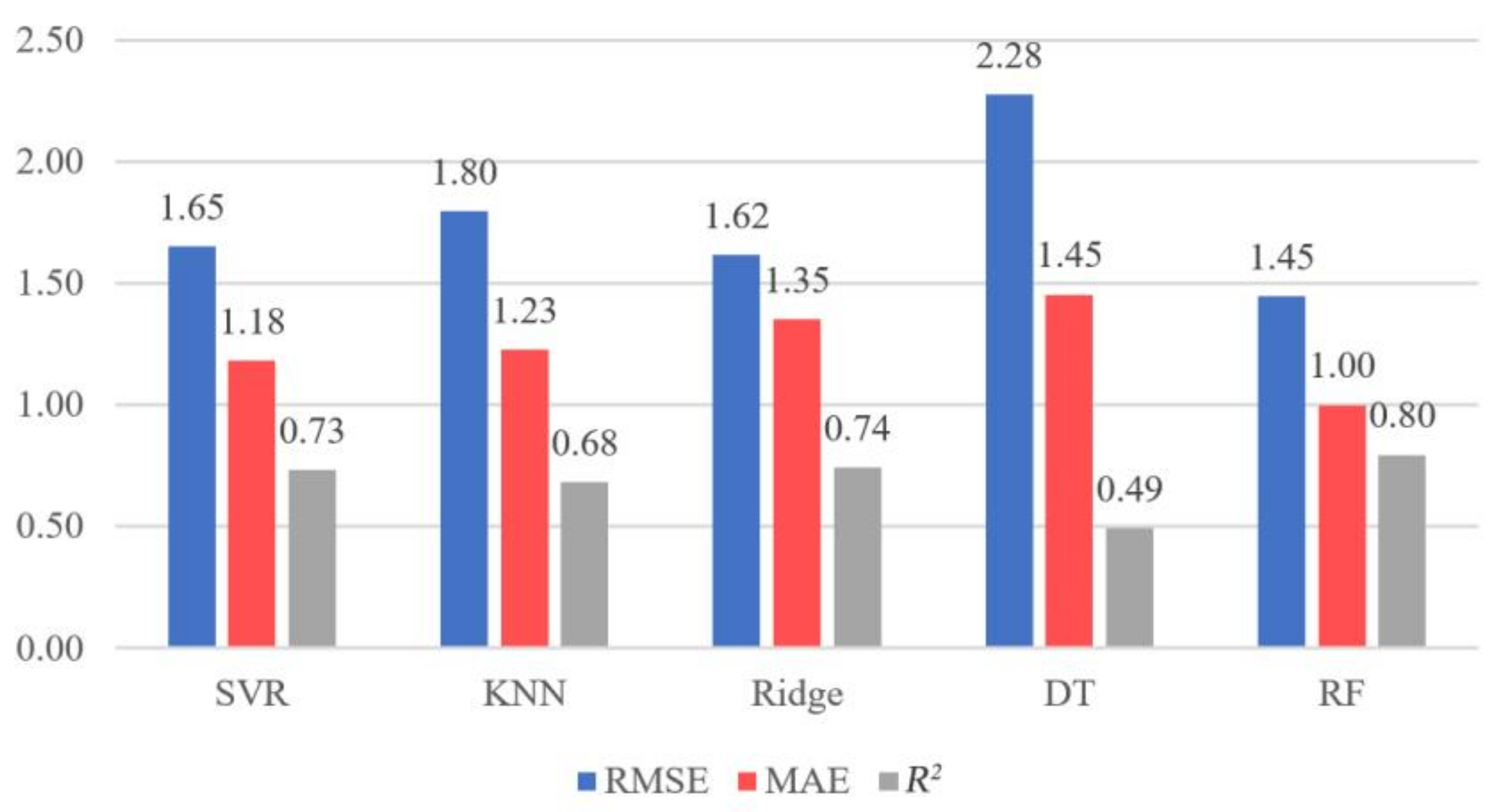
| Region | Area (km2) | Population | Built Green Space Rate (%) | Green Coverage Rate (%) | Per Capita Green Space (m2) |
|---|---|---|---|---|---|
| Guangzhou | 7434.40 | 18,734,100 | 39.26 | 43.6 | 17.33 |
| Yuexiu District | 33.8 | 1,174,500 | 29.12 | 35.36 | 5.69 |
| Parameters | Measurement Tool | Model | Manufacturer, City, Country | Unit | Resolution |
|---|---|---|---|---|---|
| Air temperature | Temperature/Relative Humidity Data Logger | Onset HOBO U23-001A | Onset Computer Corporation, Bourne, MA, USA | °C | ±0.21 °C (0~50 °C) |
| Relative humidity | Temperature/Relative Humidity Data Logger | Onset HOBO U23-001A | Onset Computer Corporation, Bourne, MA, USA | % | ±2.5% RH |
| Wind speed | Multifunctional Meteorological Anemometer | Kestrel NK5500 | NIELSEN-KELLERMAN, Boothwyn, PA, USA | m/s | Larger than record by 3% |
| Noise (Leq) | Noise recorder | TES-52A | TES Electrical Electronic Crop, Taipei, China | dB | ±1.5 dB |
| Spatial Elements | Correlation Analysis | Space Capacity | Sky View Index | Green View Index | Noise | Wind Speed | Temperature | Relative Humidity | Pedestrian Flow |
|---|---|---|---|---|---|---|---|---|---|
| Number of residents staying | Pearson | 0.263 | −0.183 | 0.309 | 0.581 * | −0.211 | −0.723 ** | 0.627 * | 0.712 ** |
| Sig. | 0.344 | 0.054 | 0.262 | 0.023 | 0.287 | 0.002 | 0.012 | 0.003 |
Disclaimer/Publisher’s Note: The statements, opinions and data contained in all publications are solely those of the individual author(s) and contributor(s) and not of MDPI and/or the editor(s). MDPI and/or the editor(s) disclaim responsibility for any injury to people or property resulting from any ideas, methods, instructions or products referred to in the content. |
© 2023 by the authors. Licensee MDPI, Basel, Switzerland. This article is an open access article distributed under the terms and conditions of the Creative Commons Attribution (CC BY) license (https://creativecommons.org/licenses/by/4.0/).
Share and Cite
Yang, X.; Fan, Y.; Xia, D.; Zou, Y.; Deng, Y. Elderly Residents’ Uses of and Preferences for Community Outdoor Spaces during Heat Periods. Sustainability 2023, 15, 11264. https://doi.org/10.3390/su151411264
Yang X, Fan Y, Xia D, Zou Y, Deng Y. Elderly Residents’ Uses of and Preferences for Community Outdoor Spaces during Heat Periods. Sustainability. 2023; 15(14):11264. https://doi.org/10.3390/su151411264
Chicago/Turabian StyleYang, Xiaolin, Yini Fan, Dawei Xia, Yukai Zou, and Yuwen Deng. 2023. "Elderly Residents’ Uses of and Preferences for Community Outdoor Spaces during Heat Periods" Sustainability 15, no. 14: 11264. https://doi.org/10.3390/su151411264
APA StyleYang, X., Fan, Y., Xia, D., Zou, Y., & Deng, Y. (2023). Elderly Residents’ Uses of and Preferences for Community Outdoor Spaces during Heat Periods. Sustainability, 15(14), 11264. https://doi.org/10.3390/su151411264











